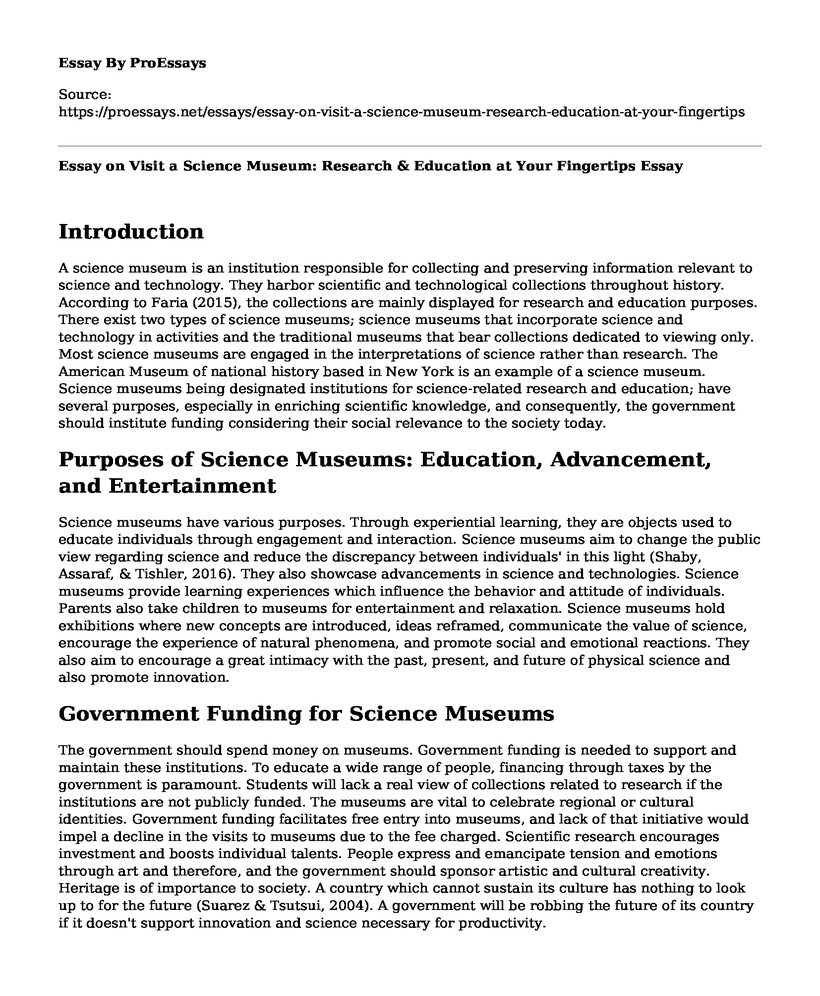Introduction
A science museum is an institution responsible for collecting and preserving information relevant to science and technology. They harbor scientific and technological collections throughout history. According to Faria (2015), the collections are mainly displayed for research and education purposes. There exist two types of science museums; science museums that incorporate science and technology in activities and the traditional museums that bear collections dedicated to viewing only. Most science museums are engaged in the interpretations of science rather than research. The American Museum of national history based in New York is an example of a science museum. Science museums being designated institutions for science-related research and education; have several purposes, especially in enriching scientific knowledge, and consequently, the government should institute funding considering their social relevance to the society today.
Purposes of Science Museums: Education, Advancement, and Entertainment
Science museums have various purposes. Through experiential learning, they are objects used to educate individuals through engagement and interaction. Science museums aim to change the public view regarding science and reduce the discrepancy between individuals' in this light (Shaby, Assaraf, & Tishler, 2016). They also showcase advancements in science and technologies. Science museums provide learning experiences which influence the behavior and attitude of individuals. Parents also take children to museums for entertainment and relaxation. Science museums hold exhibitions where new concepts are introduced, ideas reframed, communicate the value of science, encourage the experience of natural phenomena, and promote social and emotional reactions. They also aim to encourage a great intimacy with the past, present, and future of physical science and also promote innovation.
Government Funding for Science Museums
The government should spend money on museums. Government funding is needed to support and maintain these institutions. To educate a wide range of people, financing through taxes by the government is paramount. Students will lack a real view of collections related to research if the institutions are not publicly funded. The museums are vital to celebrate regional or cultural identities. Government funding facilitates free entry into museums, and lack of that initiative would impel a decline in the visits to museums due to the fee charged. Scientific research encourages investment and boosts individual talents. People express and emancipate tension and emotions through art and therefore, and the government should sponsor artistic and cultural creativity. Heritage is of importance to society. A country which cannot sustain its culture has nothing to look up to for the future (Suarez & Tsutsui, 2004). A government will be robbing the future of its country if it doesn't support innovation and science necessary for productivity.
Social Relevance of Science Museums
Museums are of social relevance. A socially responsible museum addresses issues that are relevant to a community (Abram, 2005). Museums possess stories and collections of international, national, and local significance. They pose a collective memory from which the society can derive their identity and become proud of it. It also helps to manage the cultural heritage, which is the fabric of a nation. Museums also provide a learning environment for society. Individuals learn when they view, touch, taste, and play with the collections. Therefore, people gain general knowledge, which can help boost their self-esteem. Museums also give individuals entertainment, inspiration, experience, and pleasure. The collections delineate the different blends in generation, religion, and culture, which represent an image to the society of the past, present, and future. Museums provide an economic value to the community through the employment of professionals, tour guides, and volunteers. Through exhibitions, museums also provide platforms for interaction, discussion, and debates. Museums also promote unity when they use their resources to show appreciation of the multifarious cultures that exist in society.
Science museums are national treasures that buttress education and science, and due to their significance in research and scientific innovations, they should be sponsored. The government should spearhead the fortification of these institutions and ensure accessibility to all. One of the critical reasons for financing these projects is the immense role the museums play in social and cultural coherence that in turn elevate cohesion, self-esteem and national pride.
References
Abram, R. J., DiCosimo, J., Baumann, S. H., Gallant, M., Koster, E. H., Kydd, G., & Worts, D. (2005). Looking Reality in the Eye: Museums and Social Responsibility. University Of Calgary Press.
Faria, C., Guilherme, E., Gaspar, R., & Boaventura, D. (2015). History of Science and Science Museums. Science & Education, 24(7-8), 983-1000. Retrieved from https://www.researchgate.net/profile/Elsa_Guilherme/publication/280975390_History_of_Science_and_Science_Museums/links/55ff1bdf08aeafc8ac8b98ee.pdf
Shaby, N., Assaraf, O. B. Z., & Tishler, C. E. (2016). The Goals of Science Museums in the Eyes of Museum Pedagogical Staff. Learning Environments Research, 19(3), 359-382. Retrieved from https://link.springer.com/article/10.1007/s10984-016-9211-z
Suarez, A. V., & Tsutsui, N. D. (2004). The Value of Museum Collections for Research and Society. Bioscience, 54(1), 66-74. Retrieved from https://academic.oup.com/bioscience/article-pdf/54/1/66/26894901/54-1-66.pdf
Cite this page
Essay on Visit a Science Museum: Research & Education at Your Fingertips. (2023, Jan 23). Retrieved from https://proessays.net/essays/essay-on-visit-a-science-museum-research-education-at-your-fingertips
If you are the original author of this essay and no longer wish to have it published on the ProEssays website, please click below to request its removal:
- Mongolian Empire
- Argumentative Essay Example on Management of Diverse Teams in Organizations
- Standards 3 and 4 of Naeyc Learning Methodologies Paper Example
- Socioeconomic Status Affects Language Development Paper Example
- Essay Sample on Creative and Critical Thinking
- Essay Sample on Inclusion of Exceptional Children: Ensuring Support and Development
- Essay Example on Effective Literacy Stations: Vital for Early Childhood Development







